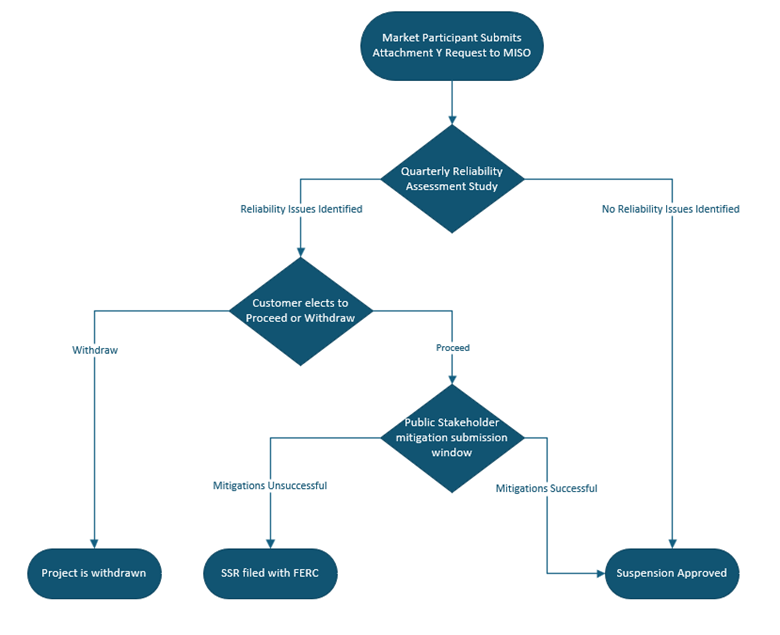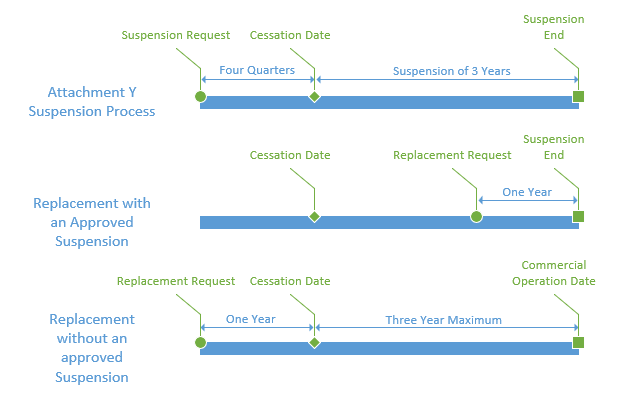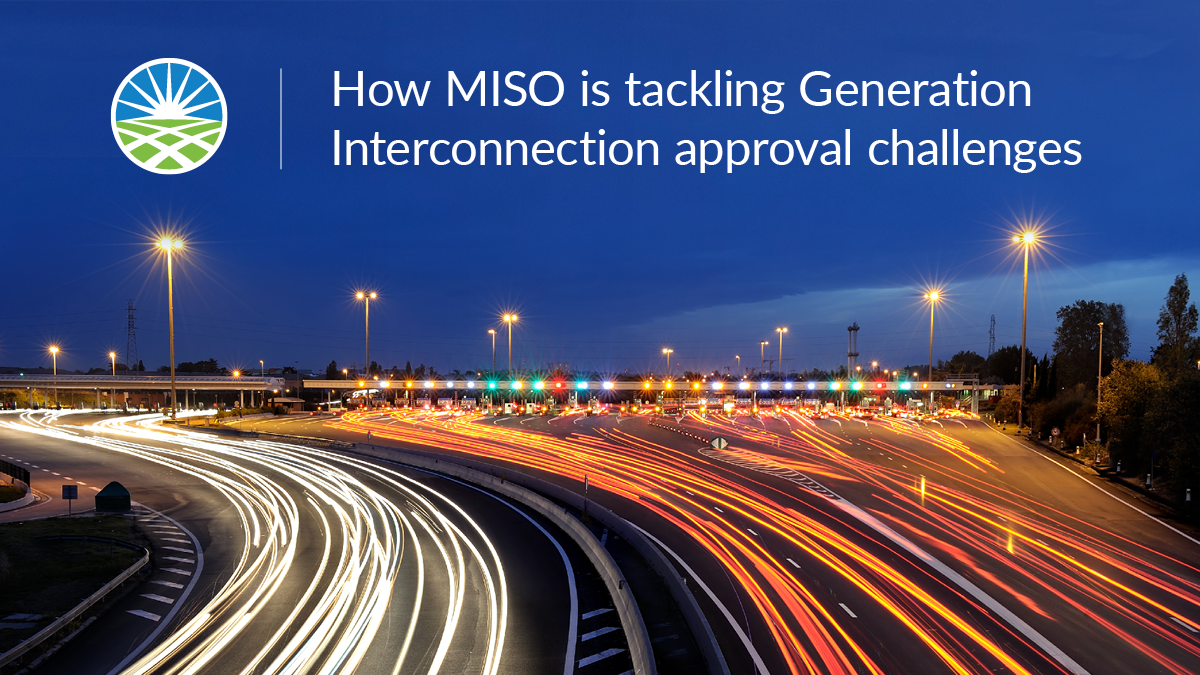MISO’s generator interconnection process vets and approves the addition of new energy sources into the MISO-controlled transmission network. It also manages generation retirement decisions to ensure that there’s enough incoming energy to replace what is phased out. It’s a non-discriminatory access system, open to generators within the MISO territory.
A successful application will result in an interconnection agreement that allows a connection to the MISO grid.
Pre-Queue
The Pre-Queue phase includes an overview of the process, timeline and expectations pertaining to the output of the Generator Interconnection process. Customers may submit an application at the end of this phase.
MISO offers regular information sessions to ensure the customer understands queue process and requirements in every phase of the process. Interconnection customers may request an ad-hoc session to discuss potential projects with MISO and the associated transmission owner.
Note: Generator Interconnection Queue applications are accepted in alignment with the existing study cycle. Applications received after the posted study cycle deadline are assigned to the next cycle. MISO charges a flat, non-refundable D1 application fee (currently $7,000). Additionally, a D2 deposit is required to fund the three Definitive Planning Phase System Impact Studies and the Facilities Study.
Application
Customers work through an online application, located on the Generator Interconnection Online Portal. All required fields and documentation must be input/uploaded before the application can be officially submitted.
MISO will acknowledge the receipt of the application within five business days from submission.
An M2 Milestone of $8,000 per MW studied (cash or irrevocable letter of credit) is also required at the time of application submission.
Application Review
The application will be reviewed by the MISO Generation Interconnection and Transmission Owner teams, and applicants will be notified via e-mail within 15 business days of any deficiencies with the application.
After receiving this notification, applicants will have 10 business days to correct any deficiencies. The application summary in the queue will list comments on the deficiencies.
The application cannot enter the generator interconnection queue until all identified deficiencies have been cleared. During this phase, MISO reviews the request, checks customer readiness, and conducts a mandatory scoping meeting.
Definitive Planning Phases (DPP)
Phase 1: Provides the Interconnection Customer with a preliminary detailed analysis of their Interconnection Request’s impact on the reliability of the Transmission System
Phase 2: Provide the Interconnection Customer a revised and detailed analysis of their Interconnection Project’s impact on the reliability of the Transmission System after incorporating updated generation assumptions resulting from the withdrawal of interconnection requests during DPP 1.
Phase 3: Provides Interconnection Customers a final, detailed analysis of their Interconnection Project’s impact on the reliability of the Transmission System after incorporating updated generation assumptions due to potential withdrawal of interconnection requests during DPP 2.
Upon completion of the DPP, the parties enter into final negotiations to create the Generator Interconnection Agreement (GIA). Once an agreement is reached, MISO files the agreement with FERC.
Note: Fees and other information change over time. Refer to BPM-015 for the most current information.
Those wishing to enter the Generator Interconnection Queue should prepare certain documents prior to applying for interconnection access. MISO provides Generator Interconnection-related updates at the Interconnection Process Working Group (IPWG) meetings.
Recommended
- Attend a Queue Process Workshop or browse online training to gain understanding of the MISO Generator Interconnection process.
- Submit an Ad Hoc Meeting request to discuss potential point-of-interconnection and interconnection project issues with the transmission owner.
- To request an informational study to aid in making project business decisions, see Appendix 5 of Attachment X for an Optional Study. Optional studies will be performed based on assumptions outlined by the interconnection customer and the results of such informational studies will be non-binding
Mandatory
A completed application includes electronic copies of each of the following items:
- Appendix 1: Application for Generator Interconnection and Attachments. If a project will be sharing Interconnection Facilities, include the Shared Facilities Consent Agreement.
- All M1 technical milestones outlined in Generator Interconnection Process Flow Diagram.
- A non-refundable application fee of $7,000 and a D2 deposit to fund the three DPP System Impact Studies and Facilities Study. Payment Submittal Example. Required cash deposits to be made out to MISO.
- M2 Milestone of $8,000 per MW studied (cash or Irrevocable Letter of Credit). Letter of Credit Template
- Demonstration of Site Control is required at least 90 calendar days prior to the kick-off of DPP Phase I. Site Control Submission Checklist
- Create an account on the Generator Interconnection online portal
Log into the Generator Interconnection Portal to submit and/or check the status of your interconnection request(s). Before starting, you may want to review the application "How To" Guide located in the Learning Center.
Need a Learning Center account? These instructions will walk you through the process.
New to the Interconnection Portal? Complete this GI Access Request form for access.
Estimated and Actual DPP Phase Start Dates by Study Area
2025 DPP Cycle Application Deadline: September 26, 2025 @ 5:00 PM Eastern
Schedule DPP-2025-Cycle Phase 1 Start Date: January 5, 2026
Non-Refundable Application Fee Deposit (D1) Update:
Effective November 14, 2023, D1 equals $7,000.
Pursuant to Attachment X, section 3.3.1, this calculated Non-Refundable Deposit 1 (D1) amount is applicable to all study groups with an application deadline that is sixty (60) or more Calendar Days after this posted date November 14, 2023.
As your associated generator interconnection projects is nearing completion through the MISO DPP process and eventual execution with FERC, the below is an overview of the next steps to registering your resource with MISO.
- Asset Registration (Commercial Model, Network Model and Market Participation)
- Testing Notification (Appendix B-1 in your GIA)
- Commercial Operation Notification (COD – Appendix E in your GIA)
For information and help with Asset registration please use the following links or call 1-866-296-6476 (option 3), Monday-Friday, 8 a.m. – 5 p.m. ET.
Market Participation Registration
For guidance and help with Testing and COD notifications please reach out to:
Khurram Ansari
All Attachment X and Attachment Y Requests are now required to be submitted through the Generator Interconnection Portal. Please refer to the "Apply" section above for access to the portal.
Attachment Y Process

The visual shown above depicts the Attachment Y process.
The Attachment Y process begins when the owner of the Generating Resource or SCU submits an Attachment Y request to MISO. The request must be submitted at least four quarters before the suspension start date of the unit. These quarters begin on March 1st, June 1st, September 1st, and December 1st.
A reliability study is performed, starting at the beginning of the quarter. The reliability study will be completed in 150 days, within reasonable efforts.
If reliability issues are identified, the customer has the option to withdraw their request or proceed through the SSR process. The customer has fifteen business days to make this decision.
If the customer chooses to proceed with the SSR process, a public stakeholder meeting seeking mitigations for the reliability issues must be held within thirty days of the customer proceeding to SSR.
If mitigations are found through the public stakeholder meeting, then the suspension is approved.
If mitigations were not found through the public stakeholder meeting, MISO will file an SSR agreement with FERC sixty calendar days prior to the suspension start date.
If no reliability issues are identified from the reliability study for suspension of the requested unit, the suspension will be approved.
The suspension period lasts a maximum of three years during any five-year period. An owner of a Generation Resource or SCU may rescind its decision to Suspend by submitting an amended Attachment Y Notice to MISO.
If a Generation Resource or a SCU or a Pseudo-tied out Generator does not return to service at the end of the three-year maximum suspension period, interconnection service of the resource will be terminated.
Replacement Timeline Requirements

The visual above shows a timeline for the Attachment Y Suspension process, replacement process with an approved suspension, and a replacement process without an approved suspension.
For the Suspension Process, the owner of the Generating Resource or SCU must submit an Attachment Y Suspension request at least four quarters before the cessation date of the unit. Upon approval, there is a suspension period of three years from the suspension start date.
For a replacement request with an approved Attachment Y Suspension request, the replacement request must be submitted at least one year prior to the suspension end date of the original unit.
For a replacement without an approved Attachment Y Suspension request, the replacement request must be submitted by the Interconnection Customer one year before the cessation date of the original unit. The new replacement unit’s commercial operations date must be within three years from the cessation date of the original unit.
What is the Generator Interconnection Process?
The Generator Interconnection Process (GI) defines the steps an interconnection customer and MISO take to move interconnection requests through the interconnection queue. The process can result in an interconnection agreement that allows the customer to connect generation to the MISO grid.
Where can I find detailed information on the current status of the queue?
Generator Interconnection Queue – Active Projects Map: Provides an interactive view of projects by fuel type, development cycle, or summer/winter net production.
Interactive Queue: Allows users to filter the interconnection queue by status, fuel type, and/or state. You can also download the complete interconnection queue spreadsheet from this page.
GIQ Web Overview: Updated monthly, this document provides a number of key data points regarding the current active interconnection queue.
MISO Generation Interconnection Business Practice Manual BPM-015: Provides the most current information relating to the generation interconnection process.
MISO Points of Interconnection (POI) Tool: Helps Interconnection Customers pre-screen for potential constraints associated with existing POIs.
MISO GI Study Metrics: Updated quarterly, provides a number of key data points regarding the MISO ongoing Generator Interconnection DPP schedule.
Note: MISO cannot publicly disclose specific project details until the Generator Interconnection Agreement is filed with FERC.
How does the GI process work and what costs are involved?
The process incorporates interaction between generator Interconnection Customers (ICs) and MISO and uses milestone achievements as a method of moving Interconnection Requests (IRs) through the queue. Milestones (represented by black diamonds in the diagram) serve as control checkpoints where MISO assesses IRs based on pre-defined criteria. Milestone achievement is a key determinant in how an IR is progressing through the process. Milestones may be technical (such as a stability model) or business-related (such as proof of Site Control). The overall process is outlined in the process flow diagram.
1. Pre-Queue: Includes an overview of the process, timeline, and expectations pertaining to the output of the Generator Interconnection process. The Pre-Queue Phase provides interested parties with regular information sessions to ensure the customer is well informed about the queue process and requirements in every phase of the process. Customers are able to submit an application at the end of this phase. Interconnection Customers also have the option to discuss potential projects with MISO and the associated Transmission Owner by requesting ad hoc sessions.
Note: GIQ applications are accepted in alignment with the existing Study Cycle. Applications received after the posted Study Cycle deadline are assigned to the next Study Cycle. MISO charges a flat non-refundable D1 application fee (currently, $7,000 in November 2023). Additionally, a D2 deposit is required to fund the three DPP System Impact Studies and Facilities Study.
An M2 Milestone of $8,000 per MW studied (cash or irrevocable letter of credit) is also required at the time of application submission.
2. Application Review: The application cannot enter the generator interconnection queue until all identified deficiencies have been cleared. During this phase, MISO reviews the request, checks customer readiness, and conducts a mandatory scoping meeting. Validated applications will receive a project number that begins with the letter “J” (JXXXX).
3. Definitive Planning: DPP Phase 1: Designed to provide the IC with a preliminary detailed analysis of their IR’s impact on the reliability of the Transmission System.
DPP Phase 2: Designed to provide the IC a revised and detailed analysis of their Interconnection Project’s impact on the reliability of the Transmission System after incorporating updated generation assumptions resulting from the withdrawal of interconnection requests during DPP 1.
DPP Phase 3: Designed to provide ICs a final, detailed analysis of their Interconnection Project’s impact on the reliability of the Transmission System after incorporating updated generation assumptions due to potential withdrawal of interconnection requests during DPP 2.
Upon completion of the DPP, the parties enter into final negotiations to create the Generator Interconnection Agreement (GIA). Once an agreement is reached, MISO files the agreement with FERC.
Note: Fees and other information change over time. Refer to BPM-015 for the most current information.
Where can I find meeting information and training on the GI process?
IPWG stakeholder meetings where the current MISO GIP is discussed in great detail
MISO Learning Center MISO has developed an exhaustive list of training for all portions of the GIP
Where can I find information regarding recent FERC Orders related to the GI process?
Transmission has been at capacity along the MISO and SPP shared border or seam, and because of the lack of transmission, developers faced significant costs to connect to the grid. MISO and SPP conducted a joint study that identified a five-project portfolio with an estimated cost of $1.6 billion.
The Joint Targeted Interconnection Queue (JTIQ) portfolio addresses significant barriers to the development of new generation along the MISO-SPP seam, enabling approximately 28.6 GW of generation to interconnect. The projects are larger and some ancillary benefits to load are expected. The JTIQ Portfolio was approved by SPP’s Board of Directors on December 9, 2024, and MISO’s Board of Directors as part of MTEP24 on December 12, 2024.
JTIQ Overview from MTEP 24 Report I JTIQ Report I JTIQ Fact Sheet
|
Project |
Location by RTO |
|
Bison – Hankinson – Big Stone South 345 kV |
MISO |
|
Lyons Co.– Lakefield 345 kV |
MISO |
|
Raun – S3452 345 kV |
MISO-SPP |
|
Auburn – Hoyt 345 kV |
SPP |
|
Sibley - 345 kV Bus Reconfiguration |
SPP |
Future capacity forecasts highlight the urgent need to accelerate new generation additions and streamline interconnection studies. MISO’s Generation Interconnection Queue (GIQ) Cap, Phase 1 automation, and January 2024 reforms—alongside Order 2023 compliance—are expected to improve queue management, though full timeline reductions may take several years.
The Expedited Resource Addition Study (ERAS) is a targeted, temporary process designed to issue a Generation Interconnection Agreement in three months. It enables reliability-critical resources to come online quickly while broader queue processing timelines are being reduced.
ERAS Informational Guide | RERRA Verification Template | ERAS-Related Tariff Redlines
|
|
2025 |
2026 |
2027 |
|
|
Quarter 1 |
Application due date |
|
2/6/2026 |
2/5/2027 |
|
Cycle kickoff |
3/2/2026 |
3/1/2027 |
||
|
Quarter 2 |
Application due date |
5/8/2026 |
5/10/2027 |
|
|
Cycle kickoff |
6/1/2026 |
6/1/2027 |
||
|
Quarter 3 |
Application due date |
8/11/2025 |
8/11/2026 |
|
|
Cycle kickoff |
9/2/2025 |
9/1/2026 |
||
|
Quarter 4 |
Application due date |
11/6/2025 |
11/6/2026 |
|
|
Cycle kickoff |
12/1/2025 |
12/1/2025 |
||
